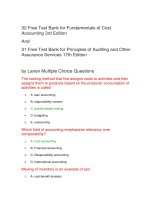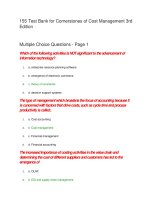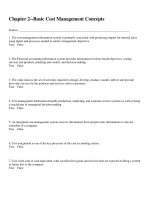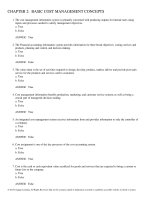Cornerstones of cost management 3rd edition hansen mowen chapter 10
Bạn đang xem bản rút gọn của tài liệu. Xem và tải ngay bản đầy đủ của tài liệu tại đây (859.09 KB, 37 trang )
DECENTRALIZATION: RESPONSIBILITY
ACCOUNTING, PERFORMANCE
EVALUATION, AND TRANSFER PRICING
CHAPTER 10
© 2014 Cengage Learning. All Rights Reserved. May not be copied, scanned, or duplicated, in whole or in part, except for use as permitted in a license distributed with a certain product or
service or otherwise on a password-protected website for classroom use.
CHAPTER 10 OBJECTIVES
1. Define responsibility accounting, and
describe the four types of responsibility
centers
2. Explain why firms choose to decentralize
3. Compute and explain return on
investment (ROI), residual income (RI),
and economic value added (EVA)
4. Discuss methods of evaluating and
rewarding managerial performance
© 2014 Cengage Learning. All Rights Reserved. May not be copied, scanned, or duplicated, in whole or in part, except for use as permitted in a license distributed with a certain product or
service or otherwise on a password-protected website for classroom use.
CHAPTER 10 OBJECTIVES
4. Explain the role of transfer pricing in a
decentralized firm
5. Discuss the methods of setting transfer
prices
© 2014 Cengage Learning. All Rights Reserved. May not be copied, scanned, or duplicated, in whole or in part, except for use as permitted in a license distributed with a certain product or
service or otherwise on a password-protected website for classroom use.
RESPONSIBILITY ACCOUNTING
• Responsibility accounting: a system
that measures the results of each
responsibility center and compares those
results with some measure of expected or
budgeted outcome
• Responsibility center: a part of the
business whose manager is accountable
for specified activities
LO-1
© 2014 Cengage Learning. All Rights Reserved. May not be copied, scanned, or duplicated, in whole or in part, except for use as permitted in a license distributed with a certain product or
service or otherwise on a password-protected website for classroom use.
RESPONSIBILITY ACCOUNTING
Types of Responsibility Centers
•Cost center: responsible only for costs
•Revenue center: responsible only for
revenues
•Profit center: responsible for both
revenues and costs
•Investment center: responsible for
revenues, costs, and investments
LO-1
© 2014 Cengage Learning. All Rights Reserved. May not be copied, scanned, or duplicated, in whole or in part, except for use as permitted in a license distributed with a certain product or
service or otherwise on a password-protected website for classroom use.
DECENTRALIZATION
• Centralized decision making: decisions
are made at the very top level and lower
level managers are charged with
implementing those decisions
• Decentralized decision making: allows
managers at lower levels to make and
implement key decisions pertaining to
their areas of responsibility
LO-2
© 2014 Cengage Learning. All Rights Reserved. May not be copied, scanned, or duplicated, in whole or in part, except for use as permitted in a license distributed with a certain product or
service or otherwise on a password-protected website for classroom use.
DECENTRALIZATION
• Decentralization: practice of delegating
decision making authority to the lower
levels
LO-2
© 2014 Cengage Learning. All Rights Reserved. May not be copied, scanned, or duplicated, in whole or in part, except for use as permitted in a license distributed with a certain product or
service or otherwise on a password-protected website for classroom use.
DECENTRALIZATION
Reasons for Decentralization
•Better access to local information
•Cognitive limitations
•More timely response
•Focusing of central management
•Training and evaluation of segment managers
•Motivation of segment managers
•Enhanced competition
LO-2
© 2014 Cengage Learning. All Rights Reserved. May not be copied, scanned, or duplicated, in whole or in part, except for use as permitted in a license distributed with a certain product or
service or otherwise on a password-protected website for classroom use.
DECENTRALIZATION
The Units of Decentralization
•Decentralization is usually achieved by
segmenting the company into divisions
•Control of cost centers is achieved by evaluating
the efficiency and the effectiveness of divisional
managers
• Efficiency means how well activities are performed
• Effectiveness can be defined as whether the
manager has performed the right activities
LO-2
© 2014 Cengage Learning. All Rights Reserved. May not be copied, scanned, or duplicated, in whole or in part, except for use as permitted in a license distributed with a certain product or
service or otherwise on a password-protected website for classroom use.
MEASURING THE PERFORMANCE OF
INVESTMENT CENTERS
Return on Investment
•Return on Investment (ROI) is the most
common measure of performance for an
investment center
ROI = Operating income / Average operating assets
ROI = (Operating income/ Sales) × (Sales / Average
operating assets)
ROI = Operating income margin × Operating asset
turnover
LO-3
© 2014 Cengage Learning. All Rights Reserved. May not be copied, scanned, or duplicated, in whole or in part, except for use as permitted in a license distributed with a certain product or
service or otherwise on a password-protected website for classroom use.
MEASURING THE PERFORMANCE OF
INVESTMENT CENTERS
Return on Investment
•Operating income refers to earnings before
interest and income taxes
•Operating assets includes all assets used to
generate operating income
Average
operating =(Beginning net book value + Ending net book value)/2
assets
LO-3
© 2014 Cengage Learning. All Rights Reserved. May not be copied, scanned, or duplicated, in whole or in part, except for use as permitted in a license distributed with a certain product or
service or otherwise on a password-protected website for classroom use.
MEASURING THE PERFORMANCE OF
INVESTMENT CENTERS
Margin and Turnover
•ROI formula is broken into two component ratios:
margin and turnover
•Margin is the ratio of operating income to sales
•Turnover is found by dividing sales by average
operating assets
LO-3
© 2014 Cengage Learning. All Rights Reserved. May not be copied, scanned, or duplicated, in whole or in part, except for use as permitted in a license distributed with a certain product or
service or otherwise on a password-protected website for classroom use.
MEASURING THE PERFORMANCE OF
INVESTMENT CENTERS
Advantages of the ROI Measure
• Encourages investment center managers to
focus on the relationship between sales,
expenses and investment
• Encourages cost efficiency
• Discourages excessive investment in operating
assets
LO-3
© 2014 Cengage Learning. All Rights Reserved. May not be copied, scanned, or duplicated, in whole or in part, except for use as permitted in a license distributed with a certain product or
service or otherwise on a password-protected website for classroom use.
MEASURING THE PERFORMANCE OF
INVESTMENT CENTERS
Disadvantages of the ROI Measure
•Discourages managers from investing in projects
that would decrease divisional ROI but would
increase profitability of the company overall
•Encourages managers to focus on the short run at
the expense of the long run
LO-3
© 2014 Cengage Learning. All Rights Reserved. May not be copied, scanned, or duplicated, in whole or in part, except for use as permitted in a license distributed with a certain product or
service or otherwise on a password-protected website for classroom use.
MEASURING THE PERFORMANCE OF
INVESTMENT CENTERS
Residual Income
•Difference between operating income and
the minimum dollar return required on a
company’s operating assets
Residual Income = Operating Income – [Minimum rate of
return × Operating assets]
LO-3
© 2014 Cengage Learning. All Rights Reserved. May not be copied, scanned, or duplicated, in whole or in part, except for use as permitted in a license distributed with a certain product or
service or otherwise on a password-protected website for classroom use.
MEASURING THE PERFORMANCE OF
INVESTMENT CENTERS
Advantages of Residual Income
•Encourages managers to move beyond the focus
of the percentage return on investment
• Refocuses the manager on dollar profit
Disadvantages of Residual Income
•An absolute measure of return that makes it
difficult to directly compare the performance of
divisions
•does not discourage myopic behavior
LO-3
© 2014 Cengage Learning. All Rights Reserved. May not be copied, scanned, or duplicated, in whole or in part, except for use as permitted in a license distributed with a certain product or
service or otherwise on a password-protected website for classroom use.
MEASURING THE PERFORMANCE OF
INVESTMENT CENTERS
Economic Value Added (EVA)
•After-tax operating profit minus the total annual
cost of capital
• If positive, the company is creating wealth
• If negative, then the company is destroying wealth
•Key feature: focuses on after-tax operating
income and the actual cost of capital employed
EVA = After-tax operating income – [Weighted average
cost of capital × total capital employed]
LO-3
© 2014 Cengage Learning. All Rights Reserved. May not be copied, scanned, or duplicated, in whole or in part, except for use as permitted in a license distributed with a certain product or
service or otherwise on a password-protected website for classroom use.
MEASURING AND REWARDING THE
PERFORMANCE OF MANAGERS
Incentive Pay for Managers—
Encouraging Goal Congruence
•Three reasons managers do not provide
good service
• They may have low ability
• They may prefer not to work hard
• They may prefer to spend company resources
on perquisites
LO-4
© 2014 Cengage Learning. All Rights Reserved. May not be copied, scanned, or duplicated, in whole or in part, except for use as permitted in a license distributed with a certain product or
service or otherwise on a password-protected website for classroom use.
MEASURING AND REWARDING THE
PERFORMANCE OF MANAGERS
Managerial Rewards
•Include incentives tied to performance
•Objective is to encourage goal congruence, so that
managers will act in the best interests of the firm
•Include salary increases, bonuses based on
reported income, stock options, and noncash
compensations
LO-4
© 2014 Cengage Learning. All Rights Reserved. May not be copied, scanned, or duplicated, in whole or in part, except for use as permitted in a license distributed with a certain product or
service or otherwise on a password-protected website for classroom use.
MEASURING AND REWARDING THE
PERFORMANCE OF MANAGERS
Cash Compensation
•Includes salaries and bonuses
•Good management performance may be rewarded
by granting periodic raises
•Unlike periodic raises, bonuses are more flexible
•Many companies use a combination of salary and
bonuses to reward performance
LO-4
© 2014 Cengage Learning. All Rights Reserved. May not be copied, scanned, or duplicated, in whole or in part, except for use as permitted in a license distributed with a certain product or
service or otherwise on a password-protected website for classroom use.
MEASURING AND REWARDING THE
PERFORMANCE OF MANAGERS
Stock-Based Compensation
•Stock is a share in the company
•Encourages goal congruence
•A stock option is the right to buy a certain number
of shares of the company’s stock, at a particular
price, after a set length of time
• The price of the stock is usually set approximately at
market price at the time of issue
• If the stock price rises in the future, the manager
may exercise the option
LO-4
© 2014 Cengage Learning. All Rights Reserved. May not be copied, scanned, or duplicated, in whole or in part, except for use as permitted in a license distributed with a certain product or
service or otherwise on a password-protected website for classroom use.
MEASURING AND REWARDING THE
PERFORMANCE OF MANAGERS
Issues to Consider in Structuring
Income-Based Compensation
•Objective is goal congruence between owner and
manager
•Single measures of performance are subject to
gaming behavior
• Managers may increase short-term measures at the
expense of long-term measures
•Another issue to be considered in structuring
management compensation plans is that owners
and managers may be affected differently by risk
LO-4
© 2014 Cengage Learning. All Rights Reserved. May not be copied, scanned, or duplicated, in whole or in part, except for use as permitted in a license distributed with a certain product or
service or otherwise on a password-protected website for classroom use.
MEASURING AND REWARDING THE
PERFORMANCE OF MANAGERS
Noncash Compensation Noncash
•Compensation is an important part of the
management reward structure
•Perquisites are also important
LO-4
© 2014 Cengage Learning. All Rights Reserved. May not be copied, scanned, or duplicated, in whole or in part, except for use as permitted in a license distributed with a certain product or
service or otherwise on a password-protected website for classroom use.
TRANSFER PRICING
• Transfer prices are the prices charged for
goods produced by one division and
transferred to another
• The price charged affects the revenues of
the transferring division and the costs of
the receiving division
• Profitability, return on investment, and
managerial performance evaluation of both
divisions are affected by transfer pricing
LO-5
© 2014 Cengage Learning. All Rights Reserved. May not be copied, scanned, or duplicated, in whole or in part, except for use as permitted in a license distributed with a certain product or
service or otherwise on a password-protected website for classroom use.
EXHIBIT 10.1—IMPACT OF TRANSFER PRICE ON
TRANSFERRING DIVISIONS AND THE COMPANY AS A
WHOLE
LO-5
© 2014 Cengage Learning. All Rights Reserved. May not be copied, scanned, or duplicated, in whole or in part, except for use as permitted in a license distributed with a certain product or
service or otherwise on a password-protected website for classroom use.









